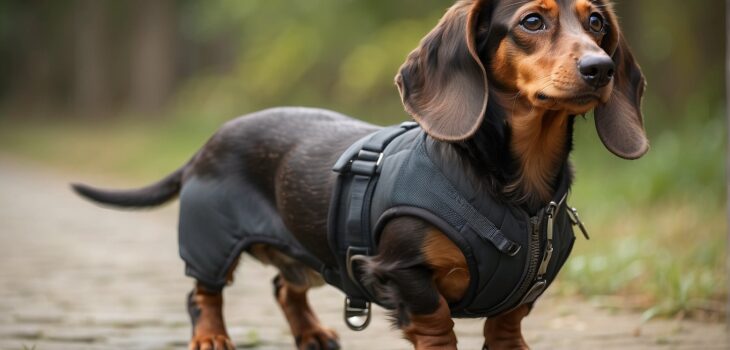Have you ever wondered how to keep your beloved Dachshund from experiencing back problems? Look no further, as this complete guide will provide you with all the information you need to prevent potential issues in your furry friend. With their long bodies and short legs, Dachshunds are prone to back problems such as intervertebral disc disease. But fear not! This comprehensive guide will equip you with the knowledge and tips necessary to keep your Dachshund’s back healthy and strong, ensuring they can continue to enjoy a happy and active life.
Understanding Dachshund Back Problems
Dachshund Back Problems: An Overview
Dachshund Back Problems are a common and serious health issue that owners of these adorable little dogs should be aware of. Due to their unique body structure, dachshunds are prone to developing back problems, particularly intervertebral disc disease (IVDD). Understanding the causes, signs, and preventive measures can go a long way in ensuring the well-being and longevity of your dachshund.
The Importance of Preventing Back Problems in Dachshunds
Preventing back problems in dachshunds is of utmost importance as these issues can cause immense pain, discomfort, and even paralysis in your furry friend. By taking proactive steps to prevent back problems, you can significantly reduce the risk of your dachshund developing such conditions and enhance their overall quality of life.
Factors Contributing to Dachshund Back Problems
Genetic Predisposition
Dachshunds have a genetic predisposition to certain back problems, mainly due to their elongated spinal structure. The genetic makeup of these dogs makes their intervertebral discs more susceptible to degeneration and injury, leading to back issues. Being aware of this genetic predisposition can help you take necessary preventive measures to mitigate the risk.

Obesity
Obesity is a common risk factor for dachshund back problems. The excess weight puts additional strain on the spine, increasing the likelihood of disc herniation and other back issues. Maintaining a healthy weight through proper diet and portion control is crucial in preventing obesity-related back problems in dachshunds.
Inadequate Exercise
Lack of regular exercise can contribute to the development of back problems in dachshunds. Exercise helps keep their muscles and joints strong, supporting the spine, and preventing strain and injuries. Engaging in appropriate exercise routines can help keep your dachshund’s back healthy and prevent the occurrence of back problems.
Inappropriate Jumping and Furniture Access
Dachshunds have a natural inclination for jumping, but excessive or improper jumping can put immense strain on their backs. Landing on hard surfaces or jumping from elevated furniture can cause injury to the intervertebral discs. It is essential to limit their access to high furniture or provide them with stairs and ramps to prevent unnecessary stress on their backs.
Signs and Symptoms of Dachshund Back Problems
Intervertebral Disc Disease (IVDD)
IVDD is a common back problem in dachshunds, characterized by the degeneration or herniation of the intervertebral discs. Symptoms may vary depending on the severity of the condition, but it often presents as pain, weakness, or even paralysis in the hind legs. IVDD requires immediate veterinary attention and appropriate treatment to prevent further complications.

Pain and Sensitivity in the Back or Neck
Dogs with back problems may exhibit signs of pain and sensitivity in their back or neck. They may yelp, whimper, or show signs of discomfort when you touch those areas. It’s essential to observe any sudden changes in their behavior and seek veterinary care if you suspect any discomfort in their back or neck.
Reluctance to Move or Jump
Dachshunds with back problems may show reluctance to engage in physical activities they once enjoyed, such as running, jumping, or playing. They may become hesitant or hesitant to climb up or down stairs, indicating potential pain or discomfort. It’s crucial to monitor their level of activity and address any changes promptly.
Abnormal Gait
Back problems can also affect a dachshund’s gait, causing them to walk with an abnormal or wobbly posture. They may exhibit a hunched back or a stiff-legged gait. If you notice any changes in your dachshund’s gait, it’s important to seek veterinary advice for a proper diagnosis and treatment.
Incontinence
In severe cases of back problems, dachshunds may experience urinary or fecal incontinence. This occurs when the nerves controlling bladder and bowel function are affected. Any signs of incontinence should be taken seriously, and immediate veterinary care is necessary to prevent further complications.
Preventive Measures to Protect Dachshund’s Back
Maintaining a Healthy Weight
One of the most crucial preventive measures to protect a dachshund’s back is to maintain a healthy weight. Obesity puts immense strain on their spine, increasing the risk of back problems. Consult with your veterinarian to determine the ideal weight for your dachshund and follow a balanced diet and portion control to ensure they maintain a healthy weight.
Proper Diet and Nutrition
A nutritious diet is essential for maintaining overall health in dachshunds, including their back health. Ensure they receive a balanced diet rich in essential nutrients, vitamins, and minerals. Avoid overfeeding and refrain from giving them table scraps or unhealthy treats, as excessive weight gain can contribute to back problems.
Regular Exercise and Physical Activity
Engaging in regular exercise and physical activity is crucial for dachshunds’ overall well-being and back health. Design an exercise routine that combines low-impact activities, such as walking and swimming, to keep their muscles and joints strong. However, it’s essential to avoid activities that involve excessive jumping or strenuous movements that can strain the back.
Controlling Jumping and Furniture Access
To prevent unnecessary strain on their backs, it’s important to control their jumping behavior and restrict access to high furniture. Consider using stairs or ramps to provide them with safe and easy access to furniture. Additionally, discourage them from jumping off elevated surfaces, such as beds or couches, to minimize the risk of back injuries.
Supportive Gear: Harnesses and Ramps
Investing in supportive gear, such as harnesses and ramps, can be highly beneficial in preventing back problems. Harnesses distribute weight evenly across the body, reducing strain on the spine during walks or outdoor activities. Ramps provide them with a safe way to navigate stairs or elevated surfaces, minimizing the risk of falls or injuries.
Dachshund-friendly Exercise and Activities
Swimming
Swimming is an excellent low-impact exercise that can help strengthen your dachshund’s muscles and improve their overall fitness. The buoyancy of water reduces stress on their joints and back while providing an enjoyable and refreshing activity. Ensure proper supervision and take necessary safety precautions when introducing your dachshund to swimming.
Low-Impact Exercises
Engaging in low-impact exercises, such as gentle walks, slow jogs, or treadmill workouts, can help improve your dachshund’s endurance and muscle tone without putting excessive strain on their back. These activities allow them to stay active and fit while minimizing the risk of exacerbating any existing back problems.
Physical Therapy and Rehabilitation
Physical therapy and rehabilitation programs specifically designed for dachshunds can play a crucial role in managing and preventing back problems. Through targeted exercises and techniques, these programs help strengthen their core muscles, improve balance, and reduce pain. Consult with a professional veterinary physical therapist for guidance on suitable therapy options for your dachshund.
Agility Training with Dachshund-specific Equipment
Agility training is a mentally stimulating and physically engaging activity for dachshunds. However, it’s essential to use dachshund-specific agility equipment that takes their unique body structure and back health into consideration. Opt for lower jumps and modified obstacles to prevent straining their backs during training sessions.
Creating a Safe Home Environment for Dachshunds
Stairs and Ramps: Safety Measures
Stairs and elevated surfaces pose a potential risk for dachshunds with back problems. Install baby gates or barriers to block access to stairs, preventing them from falling or attempting to climb without assistance. Additionally, provide ramps for them to access any elevated areas to minimize strain on their backs.
Slippery Surfaces: Prevention and Solutions
Slippery surfaces, such as hardwood or tile floors, can increase the likelihood of falls and injuries for dachshunds with weak or injured backs. Use non-slip mats or rugs to provide traction and prevent slips. Additionally, trim their nails regularly to ensure better grip on slippery surfaces.
Dachshund-Proofing the House
Dachshunds are curious creatures, and it’s important to dachshund-proof your house to minimize potential risks to their backs. Remove any hazards, such as low furniture with sharp edges, tight spaces they may try to squeeze through, or objects they can potentially jump off from. Consider using baby gates to restrict access to certain areas of the house if needed.
Suitable Beds and Sleeping Arrangements
Providing your dachshund with a suitable bed and sleeping arrangements is essential for supporting their back health. Opt for orthopedic beds that provide adequate support and cushioning for their joints and spine. Avoid high beds or couches that require jumping or provide ramps or steps for easy access to their sleeping area.
Maintaining Good Overall Dachshund Health
Regular Veterinary Check-ups
Regular veterinary check-ups are crucial for maintaining good overall health in dachshunds, including their back health. Schedule routine visits with your veterinarian to monitor their weight, assess their overall well-being, and address any concerns regarding their back. Early detection and intervention can significantly improve the prognosis of back problems.
Maintaining Dental Health
Dental health plays a vital role in the overall well-being of dachshunds. Poor oral hygiene can lead to bacteria entering the bloodstream, potentially affecting the spinal discs and increasing the risk of back problems. Implement a regular dental care routine, including brushing their teeth and providing dental treats or toys recommended by your veterinarian.
Preventing Obesity
Obesity is a significant risk factor for dachshund back problems. Ensure you provide a balanced diet, portion control, and regular exercise to prevent excessive weight gain. Regularly monitor their weight and consult with your veterinarian to make necessary adjustments to their diet and exercise routine.
Ensuring a Stress-Free Environment
Stress and anxiety can impact the overall health of your dachshund, including their back health. Create a stress-free environment at home by providing a comfortable and safe space for them, incorporating positive reinforcement training techniques, and ensuring they receive plenty of mental and physical stimulation. A stress-free environment contributes to their overall well-being and reduces the risk of behavioral and health issues.
Recognizing and Managing Dachshund Back Problems
Early Signs and Symptoms
Early recognition of back problems is crucial in preventing further complications and ensuring the best possible outcome for your dachshund. Stay vigilant and look out for subtle signs, such as changes in behavior, reluctance to move, stiffness, or any signs of pain or discomfort in their back or neck. Seek veterinary care if you notice any concerning symptoms.
When to Seek Veterinary Care
If you suspect that your dachshund is experiencing back problems, it’s important to seek veterinary care promptly. Veterinary professionals can accurately diagnose the problem and recommend appropriate treatment options. Delaying treatment can lead to further damage and potentially irreversible effects on your dachshund’s health and mobility.
Conservative Treatment Options
Conservative treatment options are often recommended for mild to moderate cases of dachshund back problems. This may include rest, medication for pain and inflammation management, physical therapy exercises, and lifestyle modifications. Your veterinarian may also suggest the use of supportive braces or harnesses to stabilize and support the back during the healing process.
Surgical Interventions
In more severe cases or when conservative treatments fail to provide adequate relief, surgical intervention may be necessary. Surgical options vary depending on the specific back problem, but they generally aim to alleviate pressure on the spinal cord, repair herniated discs, or stabilize the spine. Discuss with your veterinarian and/or a veterinary specialist to determine the most appropriate surgical approach for your dachshund.
Postoperative Care and Rehabilitation
Proper postoperative care and rehabilitation play a crucial role in the recovery and overall success of surgical interventions for dachshund back problems. This may include restricted activity, medication administration, physical therapy exercises, and regular veterinary check-ups. Following the veterinarian’s instructions and providing a supportive environment can expedite your dachshund’s healing process.
Providing Comfort and Support for Dachshunds with Back Problems
Orthopedic Beds and Cushions
Orthopedic beds and cushions are specifically designed to provide optimal support and comfort for dogs with back problems. These beds help distribute pressure evenly, reduce strain on the spine, and support the joints. Investing in a high-quality orthopedic bed or cushion can greatly enhance your dachshund’s comfort and aid in their recovery.
Heating Pads or Warm Compresses
Applying heating pads or warm compresses to your dachshund’s back can provide much-needed comfort and pain relief. The warmth helps relax muscles, increase blood circulation, and alleviate stiffness or soreness. Always ensure the temperature is safe and comfortable for your dachshund, and never leave heating pads unattended.
Physical Support Aids
Physical support aids, such as back braces or harnesses, can be beneficial in providing additional stability and support for dachshunds with back problems. These aids help limit movement in the affected areas, reduce strain, and promote proper alignment of the spine during activities. Consult with your veterinarian or a veterinary specialist to determine the most suitable support aid for your dachshund.
Emotional Support and Enrichment
Dachshunds with back problems may experience emotional distress or boredom due to limited mobility or restricted activity. Providing them with emotional support and engaging them in enriching activities can help alleviate stress and anxiety. Spend quality time with your dachshund, engage in interactive play, and provide mental stimulation through puzzle toys or gentle training sessions.
Expert Advice and Dachshund Back Problem Resources
Consulting with Veterinarians and Specialists
When it comes to dachshund back problems, seeking advice from veterinarians or veterinary specialists is crucial. They have the expertise and knowledge to accurately diagnose and manage these conditions. Consult with professionals who have experience in dachshund health to ensure the best possible care for your beloved pet.
Online Communities and Support Groups
Connecting with online communities and support groups specifically dedicated to dachshund health can provide valuable insights and support. Share experiences, ask questions, and learn from others who have dealt with similar back problems in their dachshunds. Participating in these communities can be a great source of emotional support and helpful resources.
Books and Articles on Dachshund Health
There are numerous resources available in the form of books and articles that focus on dachshund health and back problems. These resources provide in-depth knowledge, preventive measures, treatment options, and expert advice on managing and preventing back problems in dachshunds. Consider referencing reputable sources to expand your understanding of dachshund health and back problem management.
By incorporating preventive measures, recognizing early signs of back problems, and seeking appropriate care, you can minimize the risk and impact of back problems in your dachshund. Remember, your dachshund’s back health is essential for their overall well-being and happiness, so make it a priority in your care routine. A healthy and happy dachshund will bring you immeasurable joy for years to come.




